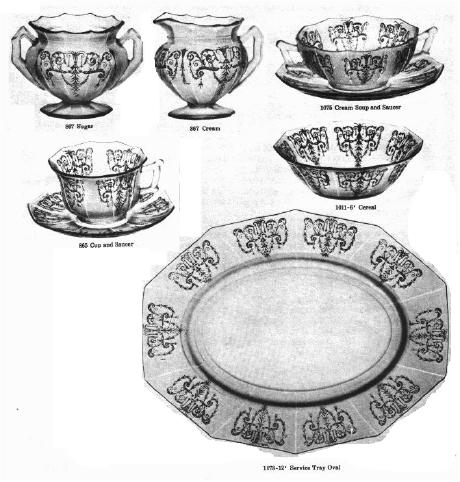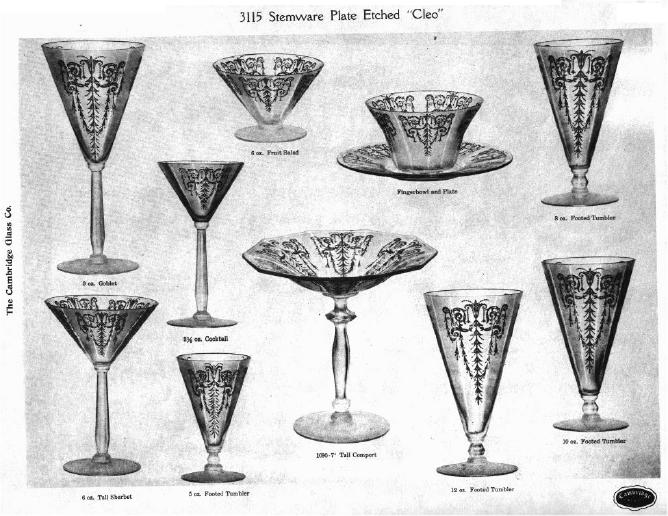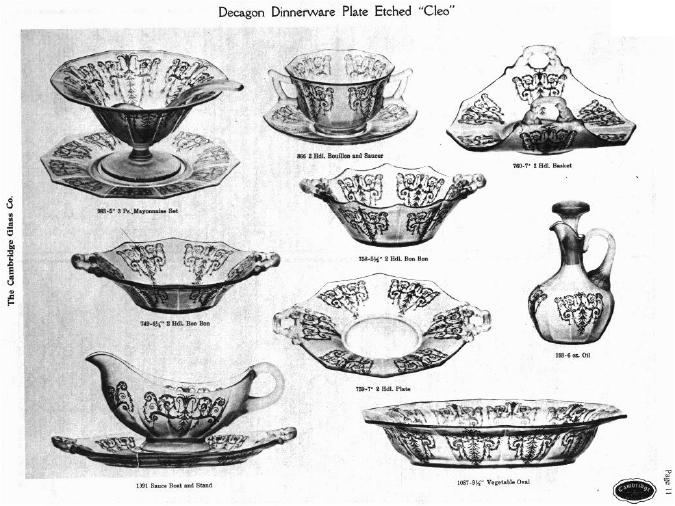Cleo - A Revisit
by Mark A. Nye
Issue No. 329 - September 2000
The first reference we have to the Cambridge etching Cleo is a catalog probably issued in 1921. The copy in the NCC archives, which were damaged in the 1998 flood and is frozen awaiting restoration, has Mr. Bennett's signature on the cover along with the notation "Correct 10/5/21." This comment is open to interpretation. It might have been either approval for issuance of a new catalog or perhaps permission to continue using a catalog issued earlier that year. Unfortunately, the catalog itself is not dated, only bearing the legend "Catalog No. 10."
On page 121 of Catalog No. 10, Cleo is shown along with etchings Nos. 407 and 515. Cleo is shown on five pieces of No. 7606 stemware 10 oz. goblet, 6 oz. tall sherbet, 6 oz. fruit salad or low sherbet, cafe parfait and the 2½ oz. wine. In addition to the stemware, the 12 oz. tumbler and the 10 oz. table tumbler from the same line are also pictured. At the time the Catalog was issued, these pieces were being made in Crystal and the author has seen all seven etched Cleo.
A Cambridge advertisement in the May 22, 1922 issue of the trade journal China Glass & Lamps featured the two etchings, Marjorie and Cleo, both shown on No. 7606 goblets. The caption read:
"Stock patterns in Deep Plate Etched glass work for you every day of the year if you have the correct ones. Marjorie and Cleo, when once started, have never failed and they have many friends."
The late Hazel Marie Weatherman published in her book Colored Glassware of the Depression Era 2 a portion of a Cambridge trade journal advertisement showing Cleo and Marjorie that she said dated to 1926. No specific trade journal was cited nor was an issue date provided.
Cambridge issued a new catalog circa spring 1927 and for the next two years issued supplemental pages. One such group, probably issued in fall 1928, contained two pages that offered a complete dinnerware set in Cleo as well as several accessory items. This constitutes the initial reference to Cleo being available on anything other than stemware.
The trade journals that this author has examined contained no further reference to Cleo until 1929. At this point references to dinnerware, luncheon sets, and tableware other than stemware etched Cleo appeared. From the January 1929 issue of Crockery and Glass Journal comes the following:
" ... Many other charming pieces and decorations are also introduced for the new year. This is especially true in regard to their (Cambridge) dinner service. Outstanding among these treatments is the Cleo etching which deserves a word of special mention. This fascinating design might best be termed an Adam treatment."
During July 1929, four consecutive weekly issues of China Glass & Lamps the Cambridge advertisement on the cover feared Cleo. These advertisements are reprinted with this article. These advertisements also serve as the initial reference to production of Cleo on colored blanks. The July issue featured the No. 1095 creamer and sugar and advertised its availability in Peach-Blo, Emerald, and Willow Blue. A week later No. 3077 stemware were the items of the week and a new color name is added: Madeira. Madiera, introduced in June 1929, was described by Cambridge as: "a light golden shade, halfway between canary yellow and deep amber."
Week three promoted tableware with the caption "From the three pieces shown may be had some idea of the very attractive glassware for table service made by Cambridge. Illustrated were the No. 1075 cream soup, the No. 749 bonbon and The No. 865 cup and saucer, all from the Decagon line. The final Cleo cover had as its focus the No. 867 sugar and cream. The last two covers listed the four colors from week two: Peach-Blo, Emerald, Willow Blue, and Madiera.
Cleo had its share of the 1930 Cambridge Catalog with five pages devoted exclusively to this etching and several other pages where it shared the spotlight with other etchings. The next and final illustrations of Cleo appear in the 1931 supplement to the 1930 Catalog. However, this should not be construed as evidence that Cleo was discontinued after 1931. All that is known at this time is that Cleo did not appear on catalog pages issued in the late 1930s, circa 1938, nor in the 1940 catalog.
Regarding Cleo in color during the 1930s, the only reference at this time is a note on the General Information Page of the 1930 catalog which states:
"Practically all items illustrated are made Crystal, as well as the prevailing transparent colors, such as Amber, Emerald, Peach-Blo, Willow Blue, and Gold Krystol. Cleo is known in all of these colors."
The 1930 catalog offered Cleo on two stemware lines: Nos. 3077 and 3115. A sales letter, Circular Letter #272 dating to fall 1929, offered No. 3115 in several color combinations: Emerald/Crystal, Amber/Crystal, Peach-Blo/Crystal, Crystal/Crystal, Willow Blue/Willow Blue, Topaz/Willow Blue, Peach-Blo/Willow Blue. In all instances the first color is the bowl color, the second is the color of the stem and foot. Of these, only the Topaz/Willow Blue was not available etched Cleo.
Pieces from two other stemware lines are known etched Cleo: Nos. 3060 and 3120. A Peach-Blo 3060 goblet etched Cleo is in the author's collection as is a No. 3120 champagne in Crystal. In another collection is a goblet with Crystal bowl and Amber stem and foot etched Cleo. Cleo is also known on Peach-Blo 3077 blanks with a gold rim band.
The primary blank used for Cleo was Decagon. However Cleo was also placed on pieces from the Round and No. 3400 lines.
 |
 |
 |
